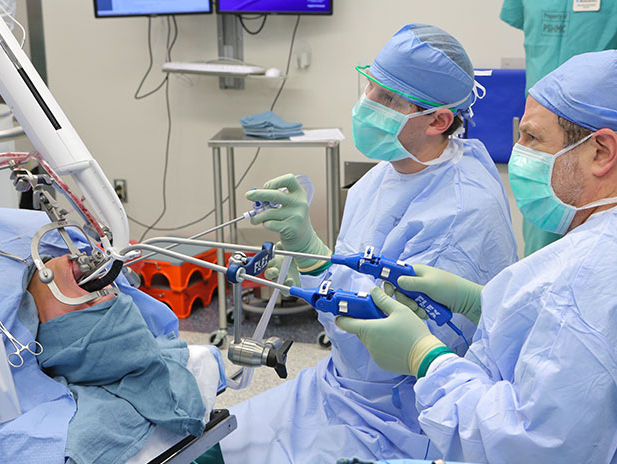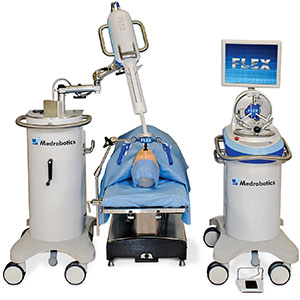
Let a snake-like robot get in from your mouth and then enter your body through the throat, which sounds a bit creepy. It is even more difficult to imagine that snake robots can get into your body from other wounds on your body.
According to foreign media reports, the flexible robot The Flex from Medrobotics has been involved in the operation of 19 patients and has received high praise from head and neck surgeons. "It really changed the way we do surgery," said David Goldenberg, head of ENT at the Hershey Medical Center in Pennsylvania. "The future of head and neck surgery is robotic." He also said that some of his colorectal surgery, obstetrics and gynecology colleagues also intend to use this robot in clinical trials.
The Flex robot entered the US market only last year (the year before it entered the European market). Medrobotics executives said that it is not an easy task to obtain permission from the relevant regulatory agencies, and the biggest problem in the process is how to ensure the robot's low intelligence to meet the requirements of the Food and Drug Administration.
"When we came in contact with the Food and Drug Administration, their first question was about the autonomy of robots. They attached great importance to the answer to this question," said Samuel Straface, CEO of Medrobotics. "We must ensure that the doctor has absolute control over the robot during surgery. If the robot overrides or has other problems, it is a problem that we need to consider in our research."
The evaluation of the surgeon and the words of the CEO of Medrobotics have briefly outlined the current status of surgical robots. Although the arrival of a new generation of surgical robots has improved the surgical ability, these robots can only be used as an aid to doctors. This is why the Food and Drug Administration explicitly prohibits automated robots in the operating room.
In addition, a special article by IEEE entitled “Would You Trust a Robot Surgeon to Operate on You?†writes: Robotics experts regard automated surgical robots as a major research goal. Recently, a fully automated surgical system that sutured the pig's large intestine more efficiently than doctors marked progress in the field. However, there is still a long way to go from the use of automated robots from the laboratory to clinical use. Straface said: "We still have to face some realities: Even if we can build this robot, it does not mean someone buys it."

The bendable robot The Flex, as its name suggests, is a flexible tubular robot. The doctor inserts it into the patient's mouth and controls its movement through the joystick. The doctor can move the robot inside the patient's trachea through a front-facing camera. Because it can see and reach very anatomic areas that are difficult to reach, surgeons such as Goldenberg begin surgery with the flexible robot The Flex, so that they do not have to perform incisions on the patient's chin or other locations. Goldenberg said that this approach is not only quick and easy for surgery, but also has lower medical costs, and it does not leave wounds for patients.
After flexing the robot to find the target, the Flex is equipped with two small tubes on both sides of the main trachea to stiffen the robot so as to provide a stable surgical platform. The doctor can switch various tools including a scalpel, scissors, and tweezers from the table.
The doctor can control the movement of the bendable robot The Flex by operating the buttons on the handle. Straface added that the system also has a foot pedal that controls the robot's power motor switch. To move the robot you must press the pedal.
The flexible robot The Flex only has an automated procedure. When the surgery is completed, the robot automatically retracts and exits the patient. Straface said that such an independent operation is acceptable because it simply returns in the direction of the doctor's insertion.
Straface then emphasized that all Medrobotics employees are very grateful to the relevant regulatory agencies for their concern for patient safety; inserting a metal object into the patient must be dangerous and no one wants to see the robot lose control in the trachea.
These security requirements also strengthen the research on robot autonomy. If the intelligent robot can reduce the risk of surgery, the Food and Drug Administration may pass. For example, these insertion robots are equipped with more sensors that can emit audible and visual alarms or automatically stop moving in the event of an impending collision with the organization. Straface said: "Automated surgical robots are not meant to replace doctors."

Goldenberg does not want the emergence of fully automated surgical robots. He said: "Not only is I afraid of being replaced by robots, but because surgery is an art that requires judgment and decision-making." It is not only the standard of performing surgery. There are many life and death related decisions. For example, sometimes the disease progresses too quickly and the surgery is useless. Goldenberg said: "Surgery requires judgment and ethics. These are things robots don't have."
Medrobotics' technical team does not plan to create an artificial intelligence robot that understands ethics. However, Straface believes that the robot's autonomy will not stop, even if there will not be a humanoid surgery robot. This is not the first time that humanity has failed to realize its own expectations. He said: "If robotics experts in the 1960s gather for a vote, they will unanimously think that the 21st century world should be humanoid. Robots do housework. However, we still have only dishwashers and sweepers."